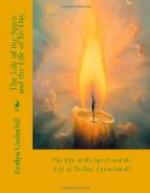A wide-spreading love to all in common, says Ruysbroeck in a celebrated passage, is the authentic mark of a truly spiritual man.[155] In this phrase is concealed the link between the social and personal aspects of the spiritual life. It means that our passional nature with its cravings and ardours, instead of making self-centred whirlpools, flows out in streams of charity and power towards all life. And we observe too that the Ninth Perfection of the Buddhist is such a state of active charity. “In his loving, sympathizing, joyful and steadfast mind he will recognize himself in all things, and will shed warmth and light on the world in all directions out of his great, deep, unbounded heart."[156]
Let this, then, be the teleological objective on which the will and the desire of individual and group are set: and let us ask what it involves, and how it is achieved. It involves all the ardour, tenderness and idealism of the lover, spent not on one chosen object but on all living things. Thus it means an immense widening of the arc of human sympathy; and this it is not possible to do properly, unless we have found the centre of the circle first. The glaring defect of current religion—I mean the vigorous kind, not the kind that is responsible for empty churches—is that it spends so much time in running round the arc, and rather takes the centre for granted. We see a great deal of love in generous-minded people, but also a good many gaps in it which reference to the centre might help us to find and to mend. Some Christian people seem to have a difficulty about loving reactionaries, and some about loving revolutionaries. And in institutional religion there are people of real ardour, called by those beautiful names Catholic and Evangelical, who do not seem able to see each other in the light of this wide-spreading love. Yet they would meet at the centre. And it is at the centre that the real life of the Spirit aims first; thence flowing out to the circumference—even to its most harsh, dark, difficult and rugged limits—in unbroken streams of generous love.
Such love is creative. It does not flow along the easy paths, spending itself on the attractive. It cuts new channels, goes where it is needed, and has as its special vocation—a vocation identical with that of the great artist—the “loving of the unlovely into lovableness.” Thus does it participate according to its measure in the work of Divine incarnation. This does not mean a maudlin optimism, or any other kind of sentimentality; for as we delve more deeply into life, we always leave sentimentality behind. But it does mean a love which is based on a deep understanding of man’s slow struggles and of the unequal movements of life, and is expressed in both arduous and highly skillful actions. It means taking the grimy, degraded, misshapen, and trying to get them right; because we feel that essentially they can be right. And further, of course, it means getting behind them to the conditions




